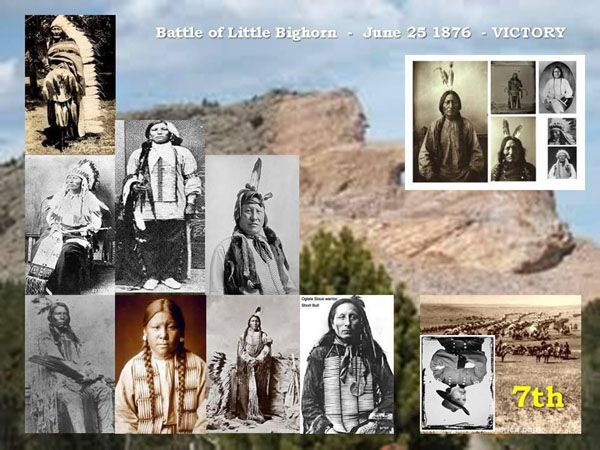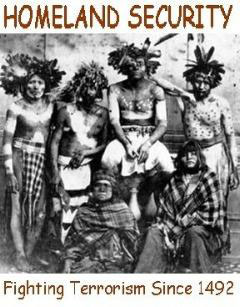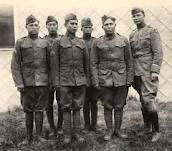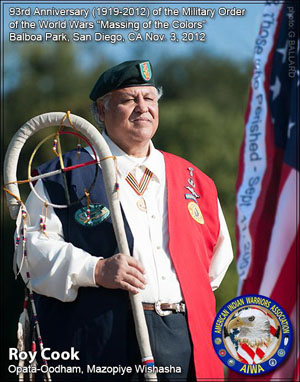Memorial
Day Thoughts 2014
By
Roy Cook
On
Memorial Day Native American Indians memorials to Indian resistance are next to
non-existent. Monuments to other military dead can be found in practically every
town of the defeated Confederacy. Twenty-two years ago, after viciously racist
verbal attacks from foes of the move, the Custer Battlefield National Monument
was renamed Little Bighorn Battlefield National Monument. Now, intermixed with
the 249 white marble 7th Cavalry gravestones are a double handful of red granite
gravestones placed at the site since 1999 for fallen Indian warriors. "Peace
through Unity" designed the innovative Indian memorial at the site (in photo).
These are steps in the right direction for the victors of that defensive battle
that fell.


One of about a dozen
red granite headstones of Lakota and Cheyenne who died at Little Big Horn in 1876.
These have been added since 1999.
Today, when the nation's war dead are remembered, when we are supposed to put aside political and ethnic divisions for a few moments of introspection, many of our politicians still won.t take a break from the lies, past and current lies, for which too many men and women went prematurely into the ground. Today, we will hear plenty from many politicians about liberty, freedom and sacrifice associated with American wars, but nothing about the plunder, raping and imperial machinations associated with some of those wars, the Mexican War, the Philippines War, the Vietnam War, the Iraq War, and, of course, the Indian Wars.
What
Is a Military Veteran? A 'Veteran' is anyone, whether active duty, discharged,
retired, or reserve military who at one point in his life, wrote a blank check
made payable to 'The United States of America, for an amount of up to and including
his life to defend the Constitution and follow the orders of the mission.
That
commitment is honor and duty in action. As veterans, we painfully realize that
there are still too many people that enjoy freedom in this country today yet no
longer understand that, freedom is not free.
Fortunately, our military
is made up of ordinary people accomplishing extraordinary things. Fewer than 10
percent of Americans can claim the title "military veteran."
1787:
U.S. Constitution Adopted.
In the debates over adopting the U.S. Constitution
there are bitter arguments over who should be allowed to vote. In particular,
the slave-states insist that only white males be allowed to vote, yet they simultaneously
demand that their Black slaves be counted when figuring up how many members of
Congress each state is entitled to.
The Constitutional Convention cannot
agree on any national voting-rights standard so they leave it up to each individual
state. This results in an absurd system whereby the Federal government determines
who can be a citizen for the nation as a whole, but each individual state determines
which of their citizens have the right to vote. Most of the states decree that
only white males are eligible to vote, and most limit the vote to those white
males who own a certain amount of property. (In other words, if you're an apprentice,
or a renter, or homeless, you can't vote.) By some estimates, less than 5% of
the total populations are eligible to vote in the election of 1800.
(Note
that under the original Constitution the only Federal office anyone could directly
vote for was Congressman because the President was elected by the Electoral College,
and Senators were appointed by the state governments. We still cannot directly
vote for the President, which is why Bush occupied the White House in 2000 even
though Gore received at least 500,000 more votes.)
1850:
Indian genocide and Asian immigration
In the early lawless years of
California statehood, the Southern CA tribes went largely unnoticed by federal
officials. Five years after the Senate illegal rejection of the 1850-1851-2 California
Indian 18 treaties, tribes in San Diego County were still uncertain of their status
and bewildered by the various government leaders who claimed dominion over them.
What was clear to the Indians was that the tribes to north received federal attention.
Establishment of the Tejon Reservation in 1851 and others in the Central Valley
over the next two years must have left the San Diego Indians wondering when land
would be aside for them. Speaking
to California Indian Superintendent Thomas J. Henley, Luiseno tribal leader Manuel
Cota spoke for many San Diego County Indians when he inquired as to why Henley
seemed predisposed to deal only with the tribes of the north. Cota asked: "Why
does he not come to see us as well as the Indians of the Tulare and the Indians
of the north ...we claim as much attention as they do."
Speaking
to California Indian Superintendent Thomas J. Henley, Luiseno tribal leader Manuel
Cota spoke for many San Diego County Indians when he inquired as to why Henley
seemed predisposed to deal only with the tribes of the north. Cota asked: "Why
does he not come to see us as well as the Indians of the Tulare and the Indians
of the north ...we claim as much attention as they do."
U. S. Congress,
House, H.S. Burton to Major E.D. Townsend, Mission San Diego, January 27, 1856,
"Report on the Mission Indians", House Executive Document. 76, 34th
Congress, 3rd Session, 1856, p. 115. "God Gave It to Us First. The Seboba
(Saboba) people are a member of the Serrano tribe. They speak the Shoshonean language
and are closely related to the Luiseno and the Juaneno. These people have traditionally
lived in the San Jacinto Valley in what is now Riverside County."
Later
in the mid1880s Soboba land was sold to white settlers as part of the breakup
of the Jose Estudillo land grant. Helen H. Jackson visited Soboba village and
provided a letter, from a young Soboba student, Ramon Caval, on the dishonorable
Tribal conditions.
Also, with the California gold rush, Asian immigration
becomes significant for the first time, mostly in the West. Under the "whites-only"
clause of the 1790 Naturalization Law, Asian immigrants cannot be citizens . but
what about their children born in America? Government officials try to avoid this
"problem" by preventing Asian women from coming ashore. These anti-Asian
oppressive laws would remain in force until 1965 and 1977.
15th Amendment
- 1870 Right to Vote
You may be surprised that the 15th Amendment does
not apply to Native-Americans or Asians because Native Americans, of all people,
were not considered to be citizens. 16,000 American Indians served in the First
World War  and in recognition
of their service were .granted blanket. citizenship in 1924 but it would not be
ratified into law until 1948 in the west. Similarly, it did not apply to Mexican-Americans
in New Mexico and Arizona because, at that time, 1870, they lived in territories
that were not yet states. While legally eligible to vote in Texas and California,
Mexican-Americans are still denied the vote through violence and economic retaliation.
Adoption of the 15th Amendment in 1870 extends voting rights to Black males .
in theory. In reality, there is massive resistance to the intent of the 15th Amendment,
particularly in the Southern states, but also in the North and Midwest. Violence
and economic reprisal are used to intimidate and prevent Black men from voting.
1870-1923: Asians denied citizenship. The Naturalization Act of 1870 amends the
1790 Naturalization Law to limit citizenship to "white persons and persons
of African descent." Thus the ban preventing Asian and Latino immigrants
from becoming naturalized citizens is continued. In 1898 the Supreme Court confirms
that children of Asians who are born in the United States are automatically citizens.
In response to this "yellow peril," over the following decades a series
of "exclusion acts," such as the Chinese Exclusion Act of 1882, and
"gentlemen's agreements," and court rulings are put in place to limit
(or prevent altogether) any further immigration by Asians. Violence, lynching,
and economic retaliation were widely used against not only African-Americans but
also Indians, Latinos and Asians whether they were citizens or not.
and in recognition
of their service were .granted blanket. citizenship in 1924 but it would not be
ratified into law until 1948 in the west. Similarly, it did not apply to Mexican-Americans
in New Mexico and Arizona because, at that time, 1870, they lived in territories
that were not yet states. While legally eligible to vote in Texas and California,
Mexican-Americans are still denied the vote through violence and economic retaliation.
Adoption of the 15th Amendment in 1870 extends voting rights to Black males .
in theory. In reality, there is massive resistance to the intent of the 15th Amendment,
particularly in the Southern states, but also in the North and Midwest. Violence
and economic reprisal are used to intimidate and prevent Black men from voting.
1870-1923: Asians denied citizenship. The Naturalization Act of 1870 amends the
1790 Naturalization Law to limit citizenship to "white persons and persons
of African descent." Thus the ban preventing Asian and Latino immigrants
from becoming naturalized citizens is continued. In 1898 the Supreme Court confirms
that children of Asians who are born in the United States are automatically citizens.
In response to this "yellow peril," over the following decades a series
of "exclusion acts," such as the Chinese Exclusion Act of 1882, and
"gentlemen's agreements," and court rulings are put in place to limit
(or prevent altogether) any further immigration by Asians. Violence, lynching,
and economic retaliation were widely used against not only African-Americans but
also Indians, Latinos and Asians whether they were citizens or not. Yet,
in WW II Lt. Dan Inouye was recommended for the Medal of Honor. The MOH was awarded
by President Clinton in June 2000. The MOH is the highest military decoration
awarded by the U.S. Government. It is bestowed to servicemen and women who risked
their lives above and beyond the call of duty during combat.
Yet,
in WW II Lt. Dan Inouye was recommended for the Medal of Honor. The MOH was awarded
by President Clinton in June 2000. The MOH is the highest military decoration
awarded by the U.S. Government. It is bestowed to servicemen and women who risked
their lives above and beyond the call of duty during combat.
1945-1960:
GIs fight for civil rights.
When Black, Latino, and American Indian
GIs return from the battlefields of WWII (and later Korea), they demanded that
all American citizens have the right to vote regardless of race. They had fought
and died for democracy abroad, yet they cannot vote at home. (One out of every
eight American GIs was an African-American; Latinos and Native-Americans also
made up significant portions of the armed forces, which for the most part were
organized on a segregated basis.) 1948:
State laws denying the vote to Native-Americans are overturned.
1948:
State laws denying the vote to Native-Americans are overturned.
In
one of the post-war period's few successful legal challenges, the Federal courts
 overturn the last
state laws with large Native American populations (Maine, Arizona and New Mexico)
that explicitly prevent Indians from voting. Violence, economic retaliation, and
different kinds of legal tricks continue to be used to prevent Native-Americans
from voting.
overturn the last
state laws with large Native American populations (Maine, Arizona and New Mexico)
that explicitly prevent Indians from voting. Violence, economic retaliation, and
different kinds of legal tricks continue to be used to prevent Native-Americans
from voting.
1965:
Passage of Voting Rights Act. It
takes 57 days of floor-fighting and mass protests in the streets of Washington
to break the filibuster by Southern Senators determined to block the Voting Rights
Act. For just the second time in history, a southern filibuster on a civil-rights
issue is defeated on a bitterly divided vote. The Act is passed and it outlaws
voting phony "requirements" . such as literacy tests that were designed
to deny the vote to people based on their race or color. This applies not only
to Blacks but also to Indians, Asians, and Mexican-Americans. The law authorizes
the Federal government to take over registration of voters in areas where local
officials have consistently denied voting rights to non-whites. And the law establishes
that fluency in English cannot be made a requirement for voting eligibility except
for Arizona and other states.
It
takes 57 days of floor-fighting and mass protests in the streets of Washington
to break the filibuster by Southern Senators determined to block the Voting Rights
Act. For just the second time in history, a southern filibuster on a civil-rights
issue is defeated on a bitterly divided vote. The Act is passed and it outlaws
voting phony "requirements" . such as literacy tests that were designed
to deny the vote to people based on their race or color. This applies not only
to Blacks but also to Indians, Asians, and Mexican-Americans. The law authorizes
the Federal government to take over registration of voters in areas where local
officials have consistently denied voting rights to non-whites. And the law establishes
that fluency in English cannot be made a requirement for voting eligibility except
for Arizona and other states.
1970: 26th Amendment lowers voting age
to 18.
Thousands of veterans under the age of 21 never came back from
Southeast Asia. Veterans and POWs still unaccountable had done more than earned
the right to vote. What was it we were fighting for in the 1960 and 70s? Where
were you then? What will you think of today about freedom for all and the history
you are living today?
Today and into the future we need to be vigilant
of suppression tactics include both legal ploys and outright deceit. For example
a number of states passed laws requiring voters to show a photo-ID before they
can cast their ballots. These laws discourage voting by the elderly and poor who
are less likely to own a car and are thus less likely to possess a valid driver
license or other form of photo ID. Finally,
most military veterans will remember that momentous time they raised their hand
and committed themselves to support: the Constitution of the United States, this
land and the orders of those appointed above them. At that time I had knowledge
of the US constitution but not too clearly as of the scope and of how it applied
to the .other. Americans.
Finally,
most military veterans will remember that momentous time they raised their hand
and committed themselves to support: the Constitution of the United States, this
land and the orders of those appointed above them. At that time I had knowledge
of the US constitution but not too clearly as of the scope and of how it applied
to the .other. Americans.
I am a military veteran (US Army Special Forces
Abn. RA, 1964-67 and Special Forces AR, 1968-1973) of the Vietnam era and assigned
to the Southern region of the U.S.A. (Louisiana, Georgia, Virginia and North Carolina).
I
have had a regional personal experience during the mid-1960 civil rights activities.
During that time there were two main issues addressed by the southern Civil Rights
Movement of the 1960s. 1. Ending the "Jim Crow" system of segregation
and 2. Winning the right to vote for Blacks (and Latinos, Native-Americans, Asians,
and others) in the South and elsewhere. This snake keeps coming back in a new
skin but with the same barriers against the right to vote poison.